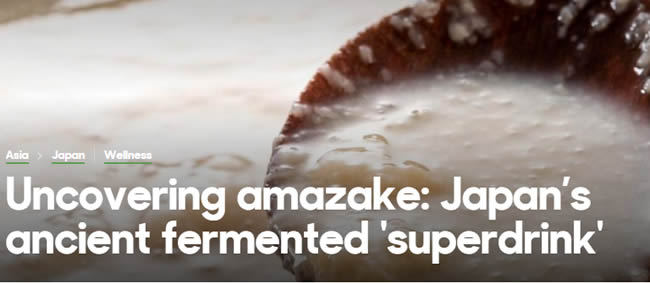先日から「Uncovering Amazake: Japan’s ancient fermented superdrink – 甘酒の秘密:日本古来のスゴイ発酵飲料」を読んでいます。

甘酒の記憶に、懐かしい思い出もよみがえる?
・「甘酒の秘密:日本古来のスゴイ発酵飲料」(1)
・「甘酒の秘密:日本古来のスゴイ発酵飲料」(2)
・「甘酒の秘密:日本古来のスゴイ発酵飲料」(3)
Sugihara fondly recalls drinking hot amazake at temples on New Year’s Eve.
杉原氏は大晦日に寺で熱い甘酒を飲んだことを、懐かしく思い出すのだとか。
Because the beverage is believed to have warming qualities (particularly due to ginger, which is often used to add flavour),
それは甘酒が体を温めるとされるためで(とりわけショウガにはその効果があり、風味づけとして甘酒にもよく使われる)、
due to~「~のため、~の結果」。
it tends to be heavily consumed during the winter months, a period that includes several major holidays, including the Hinamatsuri “Doll Festival”.
ひなまつり(人形祭り)など、主要な祝日が含まれる冬の期間に消費が増える傾向にある。
This has resulted in many Japanese people considering the drink as a tie to both their past and current national culture.
その結果、多くの日本人にとって甘酒は、国の文化の過去と現在を結ぶ飲み物になっている。
As Shihoko Ura, author of food blog Chopstick Chronicles explains, her memories of amazake are laced with a fair amount of sentimentality, particularly now that she’s migrated to Australia.
フードブログ「Chopstick Chronicles」の著者であるウラシホコ氏が言うように、彼女の甘酒にまつわる思い出は、特にオーストラリアに移住した現在、感傷的な気持ちと深く結びついている。
be laced with~「~が織り交ぜられている・混じっている、~の風味が加えられている」。
“I used to be a Red Cross-trained RN in Ise City, Mie prefecture, where there is [the] famous Ise Shrine,” she recalled.
「私はかつて、伊勢神宮で有名な三重県伊勢市の赤十字の訓練を受けた正看護師でした」と彼女は思い出す。
RN(Registered Nurse)「登録看護師、正看護師」。
“Ise shrine served free amazake for worshippers, and we first-aid employees were also offered the drink.
「伊勢神宮では参拝客に甘酒を無料で提供していて、私たち救護職員にもふるまわれました。
I was always looking forward to the sweet treat when I had a little break in [my] eight-hour shift.”
私は8時間勤務中の短い休憩での、その甘いご褒美が楽しみだったんです。」
ハードな勤務の合間に出される甘酒・・・それはきっと疲れた体に染み渡るおいしさだったのでしょうね。
伊勢神宮ならば相当な数の参拝客が来るでしょうから、用意する甘酒も相当な量のはず。
甘酒はアルコール臭もあるので、お酒に弱い人だと、匂いだけで酔ってしまいそう(笑)。
伊勢神宮の甘酒だなんて、とても健康になれそうですよね。
理由は単純明快!「少ないコストでしっかり楽しく学べるから」。
私自身の経験(高機能でビックリ)をびっしり書いていますので、良かったら読んでみてください。
下のバナーからどうぞ!






